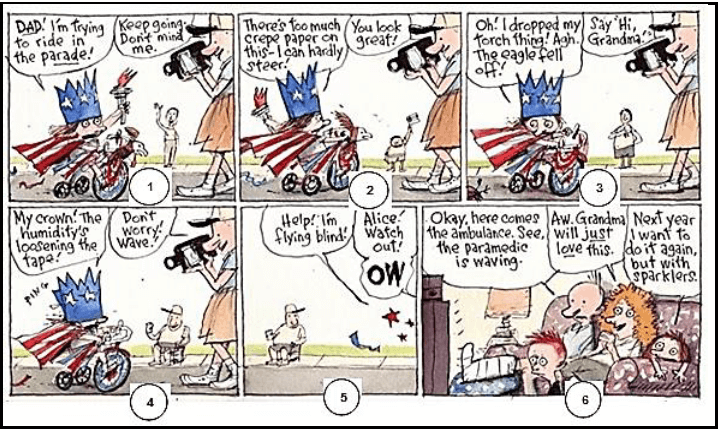English Home Language Paper 1 Grade 12 Questions - NSC Past Papers And Memos September 2020 Preparatory Examinations
Share via Whatsapp Join our WhatsApp Group Join our Telegram GroupINSTRUCTIONS AND INFORMATION
- This question paper consists of THREE sections:
SECTION A: Comprehension (30)
SECTION B: Summary (10)
SECTION C: Language structures and conventions (30) - Read ALL the instructions carefully.
- Answer ALL the questions.
- Start EACH section on a NEW page.
- Rule off after each section.
- Number the answers correctly according to the numbering system used in this question paper.
- Leave a line after each answer.
- Pay special attention to spelling and sentence construction.
- Suggested time allocation:
SECTION A: 50 minutes
SECTION B: 30 minutes
SECTION C: 40 minutes - Write neatly and legibly.
QUESTIONS
SECTION A: COMPREHENSION
QUESTION 1: READING FOR MEANING AND UNDERSTANDING
Read TEXTS A and B and answer the questions in your own words as far as possible.
TEXT A
HOW AFRAID OF HUMAN CLONING SHOULD WE BE?
- The creation of two monkeys brings the science of human cloning closer to reality. But that doesn’t mean it will happen.
- The cloning of macaque monkeys in China makes human reproductive cloning more conceivable. At the same time, it confirms how difficult it would be to clone a random adult – Adolf Hitler, say – from a piece of his tissue. And it changes nothing in the debate about whether human cloning should ever be allowed to occur.
- Since the cloning of Dolly the sheep by scientists in Scotland in 1996, several other mammals have been cloned, including dogs, cats and pigs. But the same methods didn’t work so well for primates, like monkeys, and us. So this latest step is significant, because with a bit of modification, the technique used for Dolly created cloned, apparently healthy baby monkeys. The pair made this way by scientists at the Institute of Neuroscience in Shanghai have been christened Hua Hua and Zhong Zhong.
- Crucially, the cute duo was cloned from the genetic material in the cells of a macaque foetus, not from an adult monkey. This material – the chromosomes, housed in the cell’s nucleus – was extracted from the donor cell and placed inside the egg from an adult monkey, from which its own nucleus had first been removed. The egg was then stimulated to grow into an embryo in a surrogate1 mother’s womb, to make the egg respond as if it had been fertilised.
- The important additional step – not needed for Dolly and her kind – added some molecules to the egg before implantation. These molecules could activate genes involved in embryo development. Without the encouragement of the added molecules, these genes don’t seem to “awaken” in primates, and so the embryo can’t develop. But in adult cells, those genes can’t so easily be revived, which is what still prevents the successful cloning of adult monkeys. In contrast, Dolly was cloned from cells of an adult ewe.
- The Chinese scientists want to clone monkeys to study the genetic factors behind Alzheimer’s disease. With a strain of genetically identical monkeys, they can deactivate individual genes thought to play a role in the disease and see what effect it has. Such biomedical use of primates is fraught with ethical issues – it is of course the very closeness of the relationship to humans that makes such research more informative but also more disturbing.
- But the research also reopens the debate about human reproductive cloning. No one can yet know if cloning of a human foetus would work this way, but it seems entirely possible. Human cloning for reproduction is banned in many countries. A declaration by the UN in 2005 called on all states to prohibit it as “incompatible with human dignity and the protection of human life”. Right now this advice is respected on safety grounds alone. Hua Hua and Zhong Zhong were the only live births from six pregnancies, resulting from the implantation of 79 cloned embryos into 21 surrogates. Two baby macaques were in fact born from embryos cloned from adult cells, but both died – one from impaired body development, the other from respiratory failure.
- My guess is that the success rate will improve – and that there will eventually be successful cloning from adult cells. That won’t avoid safety concerns for human cloning though, and it’s hard to see quite how the issue can ever be convincingly resolved short of actually trying it. That was how IVF2 began. Many people, including some eminent scientists, were convinced that it would lead to birth defects. But in the absence of a clear ethical framework, Robert Edwards and Patrick Steptoe were able to try it anyway in 1977. Their bold, even reckless move has now alleviated the pain of infertility for millions of people.
- It’s not hard to think up invalid reasons for human cloning, of course – most obviously, the vanity of imagining that one is somehow creating a “copy” of oneself and thereby prolonging one’s life. That notion would not only be obnoxious, but also deluded. Which is not to say that it would prevent someone from giving it a go. The fantasist “human cloning company” Clonaid, run by the Raëlian cult, which falsely claimed to have created the first cloned child in 2002, stated in its publicity material that “a surprisingly large number” of the requests it had received “come from the Los Angeles/Hollywood area”.
- Although human reproductive cloning would be foolish and lacking solid motivation, that doesn’t excuse some of the baseless reasons often advanced against it. Suggestions that a cloned child would be stigmatised and “unnatural” echo many of the earlier objections to IVF. The cloning debate reveals more about our prejudices towards reproductive technologies in general than it does about our ability to make wise decisions about biomedical advances. A good case was never made with bad arguments.
[Adapted from https://www.theguardian.com]
GLOSSARY:
1surrogate: the practice whereby a substitute mother develops an implanted egg in her uterus.
2IVF – in vitro fertilisation: a process of fertilisation where an egg is combined with sperm outside the body (in vitro) and then implanted into the uterus where the embryo develops and grows.
AND
TEXT B
[Source: http://www1.lasalle.edu]
QUESTIONS: REFER TO TEXT A.
1.1 Provide a reason for the writer’s use of the pronoun, ‘we’ in the heading of the article. (2)
1.2 Quote the word in the first two lines which shows that the writer wants to allay the fears of the reader regarding the cloning of humans. (1)
1.3 Outline the paradox in the successful cloning of the two monkeys, Hua Hua and Zhong Zhong (paragraph 2, lines 3–5). (2)
1.4 Explain in your own words why the successful cloning of the two monkeys was ‘significant’ (line 11). (2)
1.5 List the three steps in the cloning process in your own words (paragraph 4). (3)
1.6 Refer to lines 11–12: ‘… the technique used for Dolly created cloned, apparently healthy baby monkeys.’ How does the use of the word, ‘apparently’ (line 12) affect your understanding of the statement? (2)
1.7 Refer to line 15: ‘Critically, the cute duo was cloned’. Explain the writer’s intention in calling these monkeys, ‘cute’ when taking into consideration the purpose for which they have been created. (2)
1.8 How would the validity of the genetic research be affected if Hua Hua and Zhong Zhong were not ‘genetically identical monkeys’ (line 29)? (2)
1.9 Do you think the UN is correct in stating that human cloning is ‘incompatible with human dignity and the protection of human life’ (line 38)? Motivate your
answer by referring to the text. (3)
1.10 Refer to lines 59–60: ‘“a surprisingly large number” of the requests it had received “come from the Los Angeles/Hollywood area”.’
Taking into consideration the writer’s opinion as expressed in paragraph 9, comment critically on his inclusion of the above claim made by Clonaid. (3)
QUESTIONS: REFER TO TEXT B.
1.11 Identify ONE visual clue in Frame 1 which suggests that the man with the beard reacts negatively to the first speaker’s words. (1)
1.12 What does the sentence in Frame 2 convey about the speaker’s attitude? (3)
QUESTION: REFER TO TEXT A AND TEXT B.
1.13 Refer to the writer’s opinion about the ‘prejudices’ (line 65) of humans in paragraph 10 of Text A, and the statements made by the first speaker in Frame 1 of Text B.
Do you think the writer of Text A agrees with the statements made in Text B? Motivate your answer by referring to both paragraph 10 of Text A and frame
1 of Text B. (4)
TOTAL SECTION A: 30
SECTION B: SUMMARY
QUESTION 2: SUMMARISING IN YOUR OWN WORDS
You have been asked to research the detrimental effects on children of watching violence on screens. You found the following article (TEXT C) during your research on the internet. Summarise the contents of Text C IN YOUR OWN WORDS.
- Your article should include SEVEN points and NOT exceed 90 words.
- You must write a fluent paragraph.
- You are NOT required to include a title for the summary.
- Indicate your word count at the end of your summary.
TEXT C
WATCHING VIOLENCE ON SCREENS MAKES CHILDREN MORE EMOTIONALLY DISTRESSED
Children today can access media through both traditional devices, like televisions, and portable devices like laptops and tablets. With more access, children are more likely to be exposed to violent content – in real-life or cartoons where force is being used and harm is being done to a person or character. Studies show that 37% of media aimed at children have physical or verbal violence. What’s more, 90% of movies, 68% of video games, 60% of TV shows, and 15% of music videos have some form of violence. In some cases, it’s rising.
Evidence shows that this can be detrimental to young children. Around the ages of three and four, children begin to develop perceptions and expectations about the world around them – views strongly influenced by their daily experiences. If children are often exposed to scenes of violence, they may develop a view of the world as a more dangerous place than it is.
Studies found that those exposed to violence become more antisocial and emotionally distressed in terms of sadness and a lack of enthusiasm. The results were similar for boys and girls: they lack remorse, lie, are manipulative and show insensitivity to the emotions of others.
Studies also reveal significant associations between exposure to violent media and classroom attention problems. Age-appropriate programmes – like Sesame Street for kindergarteners – which aim to help children understand words or ideas, are known to help them develop language and mental skills.
On the other hand, violent films and video games often feature attractive protagonists that engage in a disproportionate number of aggressive actions. Children exposed to this type of content can develop a deformed perception of violence and its actual frequency in real life. Eventually, this can give rise to the impression that the world is an overly dangerous place filled with ill-intentioned people. People that have such a worldview are more likely to interpret an ambiguous or accidental gesture as hostile or as a personal attack.
[Adapted from http://theconversation.com]
TOTAL SECTION B: 10
SECTION C: LANGUAGE STRUCTURES AND CONVENTIONS
QUESTION 3: ANALYSING ADVERTISING
Study the advertisement (TEXT D) below and answer the set questions.
TEXT D
[Source: Alamy Stock Photo]
The text in small font reads as follows:
| Meat, potatoes and milk. Balance comes from eating a variety of foods. Because nutritionists agree, no one food provides all the necessary nutrients. At McDonald’s, we offer 100% pure American beef. We offer fish and poultry. Lettuce and tomatoes. And more. Variety in our menu means you can balance what you order. And make sure your McDonald’s meal balances with other meals you eat. Because we want McDonald’s food to fit comfortably into your well-balanced diet. Better for you. Better for us. For more information about all our menu items, ask your McDonald’s Restaurant Manager. IT’S A GOOD TIME FOR THE GREAT TASTE. |
TEXT E
[Source: Alamy Stock Photo]
The text in small font reads as follows:
| We talk about balance while promoting a diet that’s low in fibre and high in fat, sugar and salt. We leave the challenge of balancing this junk-food diet to you. IT’S A GOOD NAME FOR A SCAM. |
QUESTIONS: REFER TO TEXT D.
3.1 Account for the use of the word, ‘Balance’. Refer to the literal and figurative meaning in the context of the advertisement. (2)
3.2 Discuss the repetition of the pronouns, ‘we’ and ‘you’ in the advertisement. (2)
QUESTION: REFER TO TEXT E.
3.3 Comment on the appropriateness of the image in the context of the advertisement as a whole. (3)
QUESTION: REFER TO TEXT D AND TEXT E.
3.4 In your opinion, which advertisement would have a greater impact on the reader? Justify your choice by referring to both advertisements. (3)
[10]
QUESTION 4: UNDERSTANDING OTHER ASPECTS OF THE MEDIA
Study TEXT F and answer the set questions.
TEXT F: CARTOON
[Source: Cul de Sac cartoons]
QUESTIONS: REFER TO TEXT F.
4.1 Refer to FRAME 1.
How does the little girl feel? Motivate your answer by referring to ONE VERBAL clue. (2)
4.2 Refer to the cartoon as a whole.
Provide TWO VISUAL CLUES that indicate that the girl is travelling down the road. (2)
4.3 Account for the change in the pedestrian’s body language from FRAME 4 to FRAME 5. (3)
4.4 Comment on the cartoonist’s use of satire in FRAME 6. (3)
[10]
QUESTION 5: USING LANGUAGE CORRECTLY
Read TEXT G, which contains some deliberate errors, and answer the set questions.
TEXT G
WHO INVENTED LEGO® BLOCKS?
- If you're like most kids, you probably love to play and build things with those colourful little blocks we all know as LEGO® blocks.
- LEGO® blocks are just part of the overall line of construction toys made by the Lego Group, a company from Denmark. In adition to the colourful interlocking plastic blocks we're all familiar with, other LEGO® toys includes various other parts that allow kids to construct buildings, machines, vehicles and even robots.
- The great thing about LEGO® toys is that they can be taken apart and reused constantly over and over again to make new creations. LEGO® toys have become popular all over the world!
- The Lego Group got its start in the carpentry workshop of Ole Kirk Christiansen. He started making wooden toys in 1932. He began calling his company “Lego" in 1934, based upon the Danish phrase leg godt, which means “play well."
- The Lego Group began making it’s famous plastic interlocking blocks in 1949. Over time the blocks became very popular as the company made it part of an overall system of toys that kids could use to build an unlimited variety of things.
- The LEGO® block design still in use today was patented on January 28, 1958. Blocks from that year are still compatible with blocks made today. The Lego Group takes great pride in manufacturing precise pieces that fit firmly together, yet can be easily taken apart.
- Since 1963, LEGO® blocks have been made from a special plastic called acrylonitrile butadiene styrene or ABS. Over the last 50 years, the Lego Group has produced over 400 billion LEGO® blocks. That's enough LEGO® blocks for every person in the world to have over 60 LEGO® blocks!
- The popularity of LEGO® blocks has grown so much over the years that they were indicted into the National Toy Hall of Fame in 1998.
[Source: https://www.wonderopolis.org]
QUESTIONS: REFER TO TEXT G.
5.1 Identify a spelling mistake in paragraph 2 and rewrite the word correctly. (1)
5.2 Correct an error of concord in paragraph 2. (1)
5.3 Identify an error of redundancy in paragraph 3. (1)
5.4 ‘The Lego Group got its start in the carpentry workshop of Ole Kirk Christiansen.’ (line 11–12)
Rewrite this sentence in standard English by removing the colloquialism. (1)
5.5 Refer to line 13: ‘based upon the Danish phrase 'leg godt’.
Account for the use of italics in ‘leg godt’. (1)
5.6 Correct an error of punctuation in paragraph 5. (1)
5.7 Correct a pronoun error in paragraph 5. (1)
5.8 ‘The LEGO® block design still in use today was patented by the Lego Group on January 28, 1958.’ (line 19)
Rewrite this sentence in the active voice. (1)
5.9 ABS’ (line 24) is an example of …
- an acronym.
- an abbreviation.
- an initialism.
- a palindrome. (1)
5.10 Correct a malapropism in paragraph 8. (1) [10]
TOTAL SECTION C: 30
GRAND TOTAL: 70